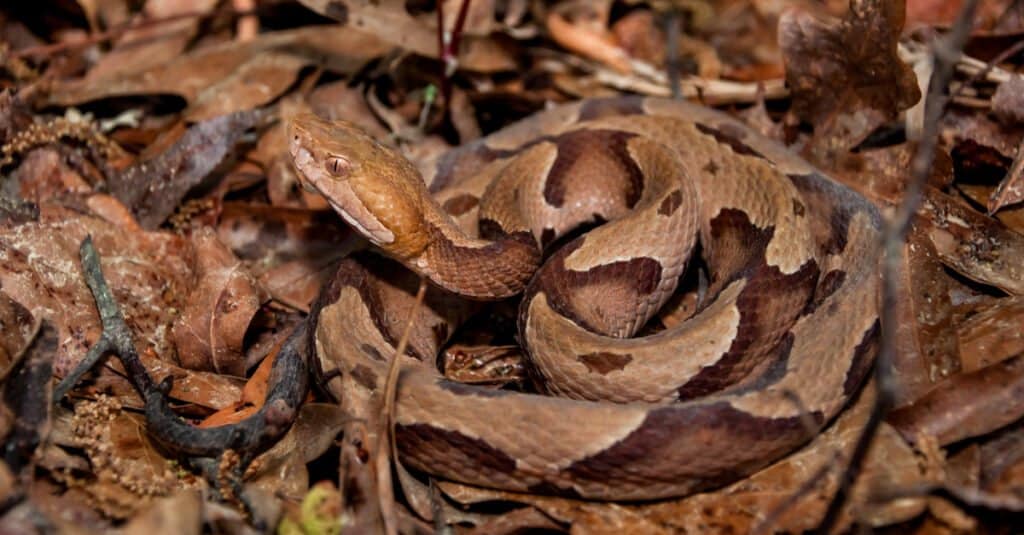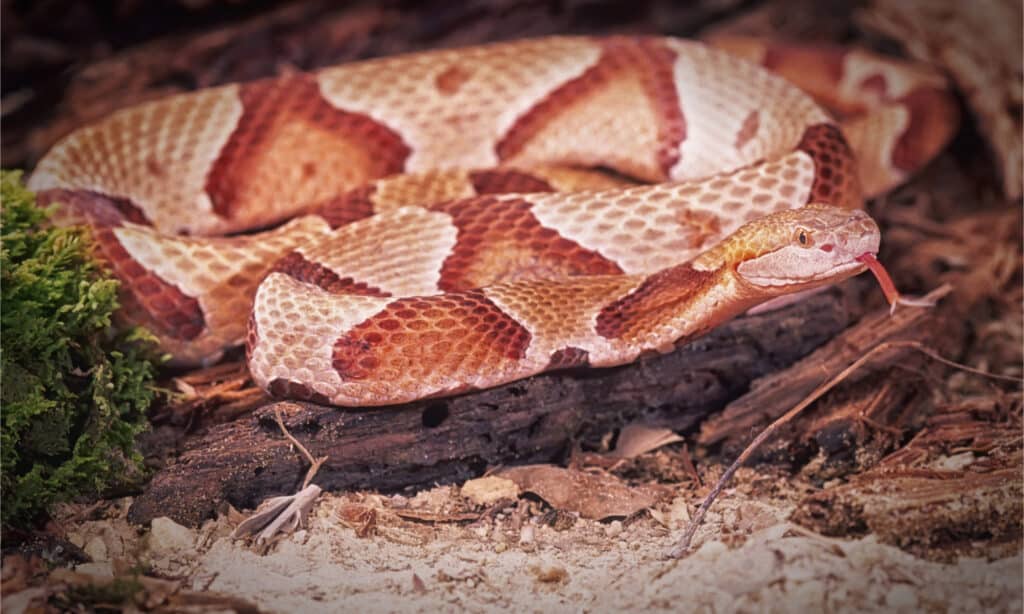Copperheads are venomous snakes that are found throughout a large swath of the United States. They live as far north as Massachusetts and as far west as Nebraska, and they’re found in many parts of Ohio. These snakes don’t have a rattle to let humans know they’re getting too close to them. That’s why it is important to know when Ohio copperheads are most active so that you can be on the lookout and know when you’re most likely to encounter them.
Bear in mind that it’s always worth keeping an eye out for snakes when you’re traveling in areas where they live. Also, if you do encounter a venomous snake, you should leave it alone. Attempting to handle snakes is a potentially fatal mistake.
Where Are Copperheads Found in Ohio?

Copperheads are primarily found in the southern and southeastern portions of Ohio.
©Jay Ondreicka/Shutterstock.com
For the most part, copperheads live in the southern half of Ohio. More specifically, they are most often found in the southeastern part of the state. That means they are encountered in Scioto, Adams, Hocking, Vinton, Jackson, and other counties in the southern part of the state.
These snakes live in many different habitats. For example, copperheads live in wooded areas, rocky and mountainous regions, or even swampy areas. Sometimes, they also wander into suburban areas and construction sites, too. Copperheads are widespread snakes.
What Do Copperheads Look Like?

The Copperhead’s scales are keeled, and their eyes have vertical pupils that make them resemble cat’s eyes.
©Creeping Things/Shutterstock.com
Copperheads often measure between 2 and 4 feet in length. They frequently appear in a brown coloration with dark splotches called crossbands that are somewhat shaped like hourglasses. Some people say that the shape is more akin to a Hershey’s Kiss, though. As juveniles, copperheads will have a distinguishable yellow tail tip.
Copperheads are often confused for other snakes, like corn snakes and reddish northern water snakes.
Copperheads can be hard to see because of their coloration. They have great camouflage that allows them to blend in well with leaves, yard debris, and wood. Sometimes, people accidentally step on or reach near these snakes because they do not see them. That can prompt the snake to deliver a bite.
When Are Ohio Copperheads Most Active?

Copperheads are beautiful, but venomous! Fortunately, their venom isn’t as dangerous as their cousin the cottonmouth.
©outdoorsman/Shutterstock.com
Copperheads in Ohio are most active in the months between April and October, from spring to the middle of fall. When the snakes emerge in spring, humans will find them in piles of leaves, under heaps of wood, and perched on rocks or logs warming themselves in sunlight. People with keen eyes can witness the snakes wrestling for breeding rights in the spring as well.
Still, copperheads are like other snakes in that they are only partially social. People in Ohio won’t find pairs of these snakes living and hunting together despite the myth that they live in pairs. Copperheads can be found in many parts of south and southeastern Ohio throughout the spring, summer, and fall months. These snakes enter a period of brumation between November and March in Ohio.
Although they’re not encountered as frequently between November and March, snakes do not truly hibernate. They will come out of their dens to sun themselves from time to time. Make sure you’re keeping an eye out for these snakes if they live in your area.
What Time of Day Are Copperheads Active?
Ohio Copperheads are most active during the day and night during the spring and fall. However, they are more active at dusk and dark during hot summer months. They can actively hunt for prey, or they can wait for prey by using their coloration as camouflage in the environment.
Are Copperheads Aggressive Snakes?
Copperheads are not overtly aggressive to humans. For the most part, they do not want to interact with humans at all. Human beings are very large and potentially dangerous to copperheads, so they do not want to attack without a good reason.
Copperheads know that attacking a human except as a last resort would be a waste of venom and could endanger their lives. So, they usually only bite humans as a last-ditch measure.
One experiment showed that only 2 out of 69 copperheads were willing to bite a simulated human in a variety of settings. For example, the scientists simulated a human stepping on the snake, walking past the snake, and grabbing and lifting the snake. In 94% of cases, the snake did not bite. They would vibrate their tails, flee, or not respond at all to the stimuli.
This study should not be interpreted to mean that copperheads are not dangerous. In fact, they can be very dangerous. However, they won’t go out of their way to harm people in most cases.
Are Copperheads Harmful to Humans?

Copperheads are venomous snakes that bite more people
©Microgen/Shutterstock.com
Yes, copperhead snakes are dangerous because they are venomous snakes with the ability to deliver painful, potentially fatal bites. The copperhead’s venom uses a hemotoxin to cause damage to the victim’s circulatory system and tissue.
According to the CDC, about 7,000 to 8,000 people are bitten by venomous snakes each year. Copperheads make up the majority of venomous snake bites in the United States with about 2,920 bites each year.
A few of the reasons that copperheads bite humans more than other venomous snakes include:
- Copperheads are more likely to rely on their camouflage to keep them hidden than to flee from humans as soon as they sense them like other snakes.
- Humans have trouble seeing them and appropriately reacting.
- They do not have a warning signal like a rattlesnake’s rattle.
- They occupy various places where humans live and travel.
Fortunately, only about 0.01% of all copperhead bites result in fatality. Despite the copperhead biting a far greater number of people, the eastern diamondback rattlesnake kills more people.
Knowing when Ohio copperheads are most active can help people achieve a greater level of awareness of their surroundings. Knowing that copperheads are active at times when hiking, fishing, and hunting are popular activities can ensure people use proper precautions to stay safe. Those precautions can include wearing proper footwear, treading slowly and carefully in wooded areas with leaf litter, and being particularly vigilant at nighttime.
The photo featured at the top of this post is © JacobLoyacano/Shutterstock.com
Discover the "Monster" Snake 5X Bigger than an Anaconda
Every day A-Z Animals sends out some of the most incredible facts in the world from our free newsletter. Want to discover the 10 most beautiful snakes in the world, a "snake island" where you're never more than 3 feet from danger, or a "monster" snake 5X larger than an anaconda? Then sign up right now and you'll start receiving our daily newsletter absolutely free.
Thank you for reading! Have some feedback for us? Contact the AZ Animals editorial team.






